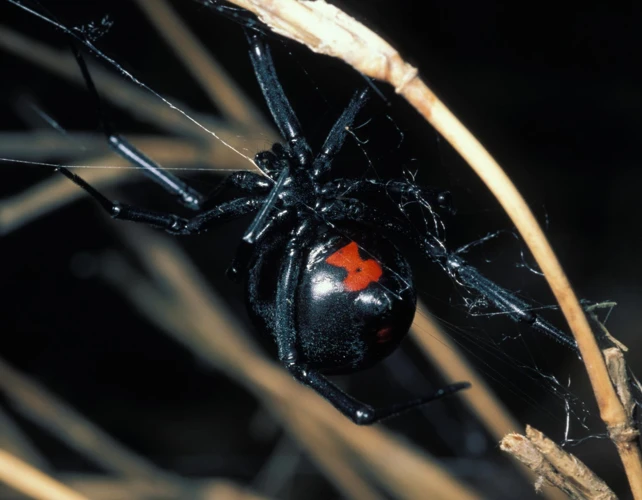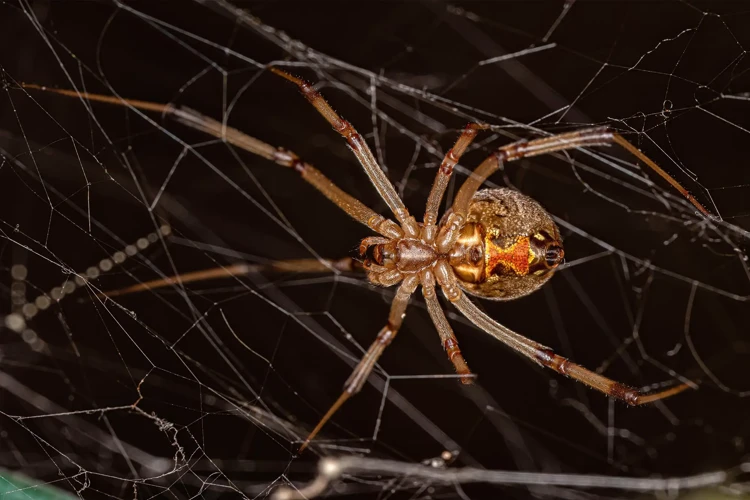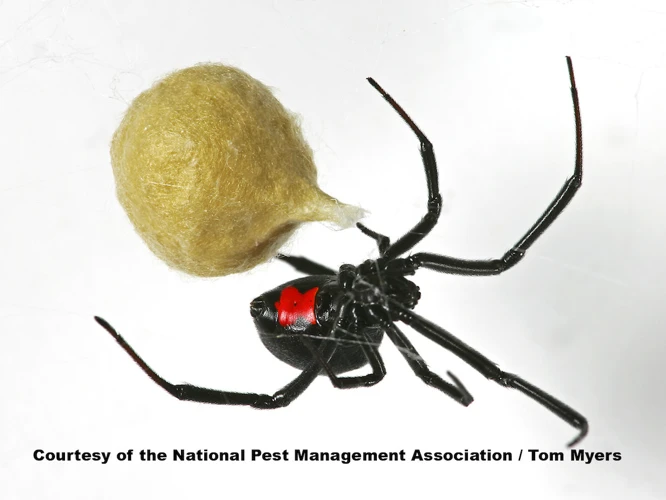As we marvel at the intricate patterns on a spider’s web and its ability to catch prey, we often forget about the tiny beings that are born into this world and need to venture out on their own. Black Widow Spiderlings are some of the most fascinating creatures to observe, especially when they start dispersing and their instincts kick in. In this article, we will delve into the world of Black Widow Spiderlings and explore how they disperse, the different methods they use, and why this process is so crucial. So, grab your magnifying glass and join us on a journey through the world of these amazing spiderlings.
What are Black Widow Spiderlings?

Discovering the Characteristics of Black Widow Spiderlings
Black Widow Spiderlings are tiny, immature spiders that belong to the Latrodectus genus of cobweb spiders. They resemble adult Black Widows, but have distinct differences in color and size. Similar to other cobweb spiders, Black Widow Spiderlings are cannibalistic, and when kept together, will often resort to intraspecific competition. Despite being small, they have unique behaviors that play a crucial role in the survival and growth of the Black Widow Spider population. In this section, we’ll delve into the appearance, habits, and behaviors of Black Widow Spiderlings.
Appearance and Habitat
Black Widow spiderlings are the offspring of female Black Widow spiders. These spiderlings go through several moulting stages before becoming adults. At the beginning of their lives, they are very small and fragile. The spiderlings are typically 3-5mm in size and appear white or yellowish in color, with tufts of hair emerging from their bodies. As they mature, the juveniles adopt a dark color, with white or red markings on their abdomens.
Black Widow spiderlings are found in a wide variety of environments, ranging from forests and grasslands to deserts and urban areas. They thrive in warm, humid environments and are often found in dry, dark places. Within their habitats, they can be found living among rocks, plant debris, and even human-made structures. Juvenile Black Widow spiders are often found near their mother’s web.
One notable trait of the Black Widow spiderlings is their social behavior. Although they are often born in clusters of hundreds, they quickly begin to compete with each other for resources, a phenomenon known as intraspecific competition. This competition can lead to the death of weaker individuals and the development of strong, dominant individuals. To avoid cannibalism, Black Widow mothers help their offspring survive by providing them with food, shelter, and protection. This phenomenon is discussed in more detail in the article “Spider Mom Helps Black Widow Survive”.
Another critical aspect of the Black Widow spiderlings is their diet, which consists mainly of insects and other small invertebrates. To capture prey, they use silk threads to create webs. The spiderlings use their venom to kill their prey and then feed on their bodies. This feeding process often occurs during the night, making it difficult for humans to observe.
Black Widow spiderlings are fascinating creatures that play a crucial role in maintaining populations of Black Widow spiders. Understanding their behavior and habitat is essential in helping to conserve the species and its habitats. For more information on Black Widow spiderlings, please read the article “From Spiderlings to Black Widow Adults”.
Behavior and Diet
Black Widow Spiderlings are the baby spiders of the Black Widow species, which belong to the Latrodectus genus. They hatch from eggs that are laid by the female Black Widow spider. In this section, we will discuss the behavior and diet of the spiderlings.
Behavior:
Black Widow spiderlings exhibit interesting behavior that is unique to their species. Once they have hatched, these spiderlings often engage in intraspecific competition in which they compete with their siblings for food and shelter. This behavior is mostly apparent when maternal care is not present, and the spiderlings are left to their devices to fend for themselves.
These spiderlings have different social behaviors which are shaped by the environment they are exposed to. They often display aggressive behavior towards each other as they struggle for resources. The emerging spiderlings frequently disperse to avoid competition. Dispersal is an important process that helps to reduce competition between spiderlings and increases their chances of survival.
Diet:
Black Widow spiderlings have a distinctive diet which plays a crucial role in their survival. They mainly feed on insects, mites, and other small arthropods. The spiderlings have an interesting hunting style that involves the use of a sticky web that traps their prey. The spiders inject digestive enzymes into the prey’s body to liquefy their internal organs, and then they consume the liquidized tissue.
The first molt which occurs about 4 -7 days after hatching allows spiderlings to become more efficient in hunting. The spiderling’s body is able to secrete different types of digestive enzymes, which enable it to break down the tough exoskeleton of its prey more easily. They become more active hunters and this change of behavior is important for their development.
Black Widow spiderlings exhibit unique behavior and dietary habits that are intricate to their species. To learn more about the Black Widow spiderlings, check out our article on the /molting-black-widow-spiderlings/.
How do Black Widow Spiderlings Disperse?

Spiderling dispersal is a crucial part of the life cycle of black widow spiders. As the spiderlings hatch from their egg sacs, they need to move away from their mother and find their own food and shelter. The dispersal process involves various methods, and the success of dispersal can affect the population of black widow spiders. Let’s explore the different ways black widow spiderlings disperse and the impact of this process.
Maternal Care
Black widow spiderlings are highly vulnerable and depend on maternal care for survival. The mother black widow spider lays hundreds of eggs and fiercely guards them until they hatch. After hatching, the spiderlings stay in the egg sac for a few weeks, receiving nourishment from the yolk. Once they have depleted the yolk, they emerge from the sac and crawl onto their mother’s back.
The following are some of the ways that maternal care ensures the survival of black widow spiderlings:
- The mother carries her spiderlings wherever she goes, protecting them from predators and providing them with warmth.
- She also actively feeds them by regurgitating food and breaking it down into small pieces. This allows the spiderlings to obtain necessary nutrients and grow quickly.
- The mother also grooms her spiderlings, keeping them clean and healthy.
- Research has shown that black widow spiderlings living in crowded conditions compete for resources such as food, shelter, and maternal attention. Maternal care is especially important in preventing intraspecific competition among the spiderlings.
Maternal care is an essential aspect of black widow spiderling survival, as it provides the young spiders with the necessary resources and protection they need to grow and eventually disperse. The next section will explore the different methods by which black widow spiderlings disperse.
Crevice and Web Escape
Black widow spiderlings are born in sacs and remain with their mothers until they are ready to disperse. One way they disperse is through crevices and webs. This method involves the spiderlings escaping from their mother’s web by using their sharp mandibles to cut through the silk. Once they have freed themselves, they explore their surroundings and may find a crevice or gap to crawl into.
Crevice and web escape is a risky but necessary survival mechanism for black widow spiderlings. They need to find new habitats where they can find food and shelter, as staying in one place may lead to competition for resources with their siblings, as well as increase the risk of predation. Staying in clusters can also increase the susceptibility of the spiderlings to diseases and parasites, making it necessary for them to disperse as they grow.
During the escape, spiderlings break through individual strands of silk, which contain an alarm pheromone that alerts the mother to the presence of a predator. This pheromone is also responsible for aggregating spiderlings. So, escaping together can lead to a higher clustering density, thereby increasing competition and risk of disease. Although black widow spiderlings use this method to disperse, it is not always successful as they can often fall prey to predators such as birds, lizards, and other small mammals.
Crevice and web escape is just one of the ways that black widow spiderlings disperse. Other methods include wind dispersal, maternal care, and philopatry. Spiderlings can also be carried away by the wind as they are lightweight and can drift away from the mother’s web. Alternatively, they can stay within their mother’s web until they are large enough to leave, or they can stay close to the web in a process known as philopatry.
The dispersal of spiderlings is crucial for the survival and growth of black widow spider populations. By dispersing, spiderlings reduce competition and overcrowding, as well as increase gene flow, leading to diverse and adaptable populations. If you want to read more about the importance of spiderlings in black widow spider populations, click on this internal link: The importance of spiderlings in black widow spider populations.
Wind Dispersal
One of the ways black widow spiderlings can disperse is through wind. During their early stages of life, spiderlings climb to elevated locations, such as tall plants or structures, to potentially catch the wind and be carried away. This allows them to find new areas to inhabit and reduce the effects of intraspecific competition. Wind dispersal can also help spiderlings avoid their siblings and reduce the likelihood of cannibalism.
However, wind dispersal can also have negative effects on spiderlings. If they are carried too far away from their maternal nest, they risk being in unfamiliar territory without the support of their mother, who provides protection and food. Additionally, if the wind carries the spiderlings to unsuitable habitats or into the path of predators, their chances of survival dramatically decrease.
It is important to note that wind dispersal is just one of several ways in which black widow spiderlings disperse. Other factors such as maternal care, crevice and web escape, and philopatry also play important roles in their dispersal and survival. To learn more about black widow spiderlings and their behaviors, you can check out our article on social behavior or identification of black widow spiderlings.
Philopatry or Staying Close to Home
One interesting aspect of black widow spiderling dispersal is the phenomenon of philopatry, which refers to the tendency of animals to remain within or return to their natal area. In the case of black widow spiders, some spiderlings may choose to stay close to their birthplace rather than disperse far away.
This behavior is not entirely understood, but it may be related to resource availability and the benefits of intraspecific competition. Research has shown that juvenile black widows in close proximity tend to compete for resources such as food and shelter, which can result in higher survival rates and improved growth. Alternatively, staying close to home may also increase the chances of finding a mate within a short distance, which can be especially important for male black widows, since they have a shorter lifespan compared to females.
However, not all black widow spiderlings exhibit philopatry, and some are more likely to disperse over longer distances in search of new resources and habitats. The choice to stay close or venture out may depend on a number of factors, including the population density of other spiders, the presence of predators, and the availability of suitable nesting sites. Understanding the complex behaviors and strategies of black widow spiderlings can provide valuable insights into the ecology and evolution of these fascinating creatures.
| Intraspecific competition | Competition among juvenile black widows for resources such as food and habitat |
| Male lifespan | The shorter lifespan of male black widows and the importance of finding a mate quickly |
| Diet and hunting | The types of prey black widow spiderlings consume and their hunting strategies |
| Finding food and shelter | The challenges faced by black widow spiderlings in locating suitable resources and habitats |
The Importance of Spiderling Dispersal
Spiderling dispersal in black widow spiders is a crucial stage in their life cycle that has far-reaching impacts on both population dynamics and gene flow. Understanding the importance of spiderling dispersal is essential to comprehend the behavior of these spiders correctly.
Population Dynamics
The dispersal of spiderlings in black widow spiders plays a vital role in maintaining and regulating population size. Without successful dispersal, a population can become inbred, which increases the risk of genetic disorders and decreases survival chances. Dispersal, therefore, helps maintain genetic diversity, which is crucial for the survival of the population.
Gene Flow
Gene flow is the transfer of genes between populations and is essential for the continued evolution and adaptation of species. Dispersal of spiderlings in black widow spiders allows for gene flow and prevents the isolation of subpopulations, reducing the likelihood of inbreeding.
Range Expansion
Dispersal allows species to colonize new areas and thus increase their range. In black widow spiders, the dispersal of spiderlings is essential in expanding the range of the species, especially when populations experience environmental stress or habitat destruction. This expansion of range can increase the number of habitats that a species can occupy, further increasing its chances of survival in diverse environments.
Biosecurity Implications
Spiderling dispersal also has implications for biosecurity. The movement of spiderlings during dispersal can increase the spread of invasive species or pests, which can have devastating effects on native flora and fauna. Careful monitoring and management of spider populations and the dispersal mechanisms can help prevent the spread of these invasive species.
The dispersal of spiderlings in black widow spiders is critical for maintaining genetic diversity, ensuring gene flow, expanding the range of the species, and aiding biosecurity. Understanding the importance of dispersal can help in the management and conservation of these spiders, ensuring their continued survival in changing environments.
Conclusion
The dispersal of spiderlings in Black Widow spiders is a fascinating topic, showcasing the complex behaviors and survival mechanisms of these creatures. As we have seen, Black Widow spiderlings are born with a strong instinct to disperse and establish their own territories. They can achieve this through different means, such as maternal care, crevice and web escape, and wind dispersal.
It is vital to understand the dispersal strategies of Black Widow spiderlings as it allows us to appreciate their vital role in the ecosystem. These tiny creatures play an essential role as predators, controlling the populations of different insects and pests. By understanding their dispersal mechanisms, we can also better understand their distribution patterns and populations, which can be helpful in creating conservation strategies.
In addition, the study of spiderling dispersal can provide insights into the evolution and genetics of these species. By studying their dispersal patterns, scientists can understand how these spiders have adapted to different environments and how they have evolved over time. These studies may also help to predict how future changes in the environment may affect these spider populations and initiate mitigation actions.
In conclusion, the dispersal of spiderlings in Black Widow spiders is a complex and fascinating phenomenon that showcases the importance of these creatures in the ecosystem. Understanding their behavior and survival mechanisms can help us protect and conserve these species in the long run.
Frequently Asked Questions
What is the average lifespan of a Black Widow Spider?
The average lifespan of a female Black Widow Spider is around three years. Males, on the other hand, generally only live for a few months.
Are Black Widow Spiderlings dangerous?
Black Widow Spiderlings are not considered dangerous to humans. However, female Black Widows can be venomous and potentially deadly.
How do Black Widow Spiderlings differ from adult Black Widows?
Black Widow Spiderlings are significantly smaller than adult Black Widows and lack the species’ distinctive red hourglass marking.
What is maternal care in Black Widow Spiders?
Maternal care in Black Widow Spiders refers to the female’s protection and nurturing of her eggs and eventual spiderlings. During this time, the female may even sacrifice herself to defend her eggs and young.
What other spiders are commonly mistaken for Black Widows?
Spiders such as the False Black Widow and the Redback Spider are often mistaken for Black Widows due to their similar appearance.
Do all Black Widow Spiderlings disperse in the same way?
No, Black Widow Spiderlings may disperse in different ways depending on their environment and other factors such as wind conditions.
What is crevice and web escape?
Crevice and web escape refers to the method of Black Widow Spiderling dispersal where they wiggle through small crevices or escape on strands of silk from their mother’s web.
What is wind dispersal?
Wind dispersal is a method of Black Widow Spiderling dispersal where young spiders are carried by the wind to different locations away from their mother’s web.
What is philopatry?
Philopatry refers to the behavior of some Black Widow Spiderlings to stay close to their mother’s web rather than disperse, potentially to avoid predator threats.
Why is understanding spiderling dispersal important?
Understanding spiderling dispersal can give insights into population dynamics and the survival of endangered species. It can also provide valuable information for pest management and control strategies.







